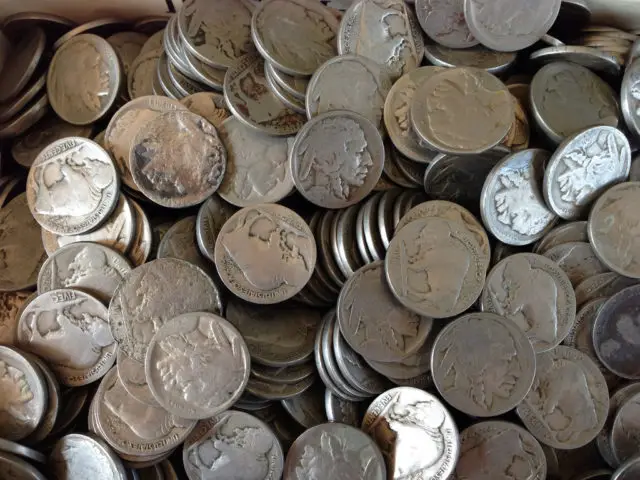Buffalo nickels are one of America’s most-loved 20th century coins.
They are truly a piece of Americana — with an American Indian on the obverse and a bison on the reverse.
Buffalo nickels have been widely collected for decades.
Here are some little-known facts about Buffalo nickels, and the values of Buffalo nickels…
Buffalo Nickel History
The Buffalo nickel was designed by James Earle Fraser and was first struck in 1913.
The Jefferson nickel replaced the Buffalo nickel design in 1938.
These nickels touched the lives of everyone in our nation.
They touched even the homeless — who used to carve their own designs on Buffalo nickels and pass them off as art. These Hobo nickels were exchanged for meals, goods, and services.
Most Buffalo nickels are priced in circulated grades at rates many coin collectors can easily afford. Along with the romance behind these pieces is also the collectibility factor.
These coins enjoyed widespread circulation into the 1950s and 1960s, and a number were found in circulation as recently as the 1970s and early 1980s.
Most older coin collectors remember pulling these coins out of circulation decades ago.
Older and younger coin collectors alike appreciate the history, lore, and relative ease of building a complete Buffalo nickel collection.
Buffalo Nickel Values In 1994 vs. In 2009
See how much prices have increased for certain Buffalo nickels since the 1994 edition of A Guide Book of United States Coins (By R.S. Yeoman and Kenneth Bressett and published by Whitman) was released.
Let’s compare the price charts in that book to some of the Buffalo nickel pricing data in the 2009 edition to see how Buffalo nickel values changed over time:
- 1913-S Variety I: $11 to $100 in Good to Mint-State 63 (1994)
- 1913-S Variety I: $38 to $180 in Good to Mint-State 63 (2009)
- 1913-D Variety II: $34 to $225 in Good to Mint-State 63 (1994)
- 1913-D Variety II: $100 to $375 in Good to Mint-State 63 (2009)
- 1913-S Variety II $75 to $400 in Good to Mint-State 63 (1994)
- 1913-S Variety II $325 to $1,300 in Good to Mint-State 63 (2009)
- 1918-D, 8 over 7: $350 to $20,000 in Good to Mint-State 63 (1994)
- 1918-D 8 over 7: $1,000 to $65,000 in Good to Mint-State 63 (2009)
- 1921-S: $15 to $1,550 in Good to Mint-State 63 (1994)
- 1921-S: $70 to $2,200 in Good to Mint-State 63 (2009)
- 1924-S: $5 to $1,950 in Good to Mint-State 63 (1994)
- 1924-S: $15 to $4,250 in Good to Mint-State 63 (2009)
- 1926-S: $6 to $2,900 in Good to Mint-State 63 (1994)
- 1926-S: $18 to $10,000 in Good to Mint-State 63 (2009)
- 1931-S: $3.50 to $65 in Good to Mint-State 63 (1994)
- 1931-S: $15 to $100 in Good to Mint-State 63 (2009)
- 1935 Doubled-Die Reverse: $150 to $200 in Fine to Very Fine (1994)
- 1935 Doubled-Die Reverse: $100 to $160 in Fine to Very Fine (2009)
- 1935 Doubled-Die Reverse: $400 to $1,300 in Extra Fine to Mint-State 63 (1994)
- 1935 Doubled-Die Reverse: $425 to $14,500 in Extra Fine to Mint-State 63 (2009)
- 1936-D 3-1/2 Legs: $300 to $750 in Fine to Very Fine (1994)*
- 1936-D 3-1/2 Legs: $1,500 to $5,000 in Fine to Very Fine (2009)*
- 1937-D 3-Legged: $100 to $3,000 in Good to Mint-State 63 (1994)
- 1937-D 3-Legged: $550 to $5,750 in Good to Mint-State 63 (2009)
*The 1994 edition shows only Fine and Very Fine prices; the 2009 edition shows prices for all grades but only Fine and Very Fine 2009 prices are shown for comparison consistency and accuracy.
Well, as you can see the Buffalo nickel market did very well over the past 15 years.
One exception is the lower grades of the 1935 Doubled-Die nickels. According to A Guide Book of United States Coins, that nickel has decreased in value over 15 years. Note the higher grades of that coin did increase.
What Does All This Mean?
Buffalo nickels are a coin collector favorite, and they certainly have done well for investors who entered the market years ago and today still hold the coins they bought back then.
However, this information should be used for entertainment and educational purposes only. This is not meant to be used as an investing guide. Coins represent a volatile market that has seen major price swings over the years. There really is no truly “guaranteed” investment in coins.
You should use this advice merely as a way to gain insight on what the Buffalo nickel market has been like over the last 15 years. You should not necessarily use it as an insight as to what may happen in the years to come.





